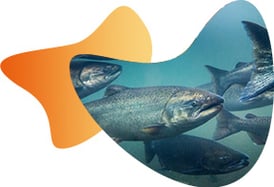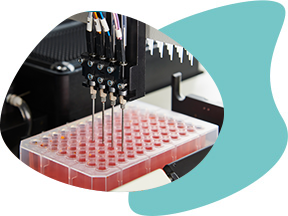Originally published : Tue, June 14, 2022 @ 6:37 PM
Updated : Mon, April 17, 2023 @ 8:33 AM
This is the second blog in a two-part series exploring solutions for infectious diseases in aquaculture. In the first blog, we explored common treatment methods for managing aquaculture diseases and introduced the concept of using genomic tools to breed for disease resistance. This blog post discusses specific genomic technologies that can help advance disease resistance in aquaculture species and details practical examples of how these tools are used.
Advances in genomic technologies are delivering more options for exploring genetic variation within populations to advance and achieve breeding objectives. Next generation sequencing (NGS) genotyping applications and PCR-based genotyping each offer distinct advantages and limitations for aquaculture breeders who want to improve disease-resistance traits. Today, there are suitable agrigenomic technologies to fit most breeding objectives and budgets and most are easy to incorporate into current breeding workflows.
Genomic tools for improving disease-resistance traits
 Historically, selective breeding programmes for improving disease resistance traits have relied on subjecting a population to specific pathogens to evaluate phenotypic response and identify the individuals that showed the greatest resistance or survival. This extreme practice leaves the challenged fish unviable for breeding; therefore, a sib is chosen, which often limits the genetic progress of each generation.1
Historically, selective breeding programmes for improving disease resistance traits have relied on subjecting a population to specific pathogens to evaluate phenotypic response and identify the individuals that showed the greatest resistance or survival. This extreme practice leaves the challenged fish unviable for breeding; therefore, a sib is chosen, which often limits the genetic progress of each generation.1
Genomic information is especially valuable for disease-resistance screening because researchers can use genetic markers to identify siblings with high-performance traits. Using a non-invasive tissue sampling method, breeders can test many siblings for specific traits of interest. These markers, or single nucleotide polymorphisms (SNPs), can detect base-pair differences that help breeders identify which individuals carry optimal alleles for the trait of interest. Genomic analyses can improve selection accuracy and minimise breeding efforts because only individuals with favourable alleles are chosen for further breeding. It’s estimated that marker-based breeding can increase selection accuracy and the amount of genetic improvement by an average of 25% or more.2
Genomic selection also gives breeders more accurate information about the genetics that affect resistance than traditional selective breeding methods. One of the major advantages of genomic selection over conventional selective breeding for disease-resistance traits is that once a detailed assessment of a separate training population has taken place, candidates in the main breeding program can be screened without exposure to a disease, enabling breeders to use them as breeding stock later. The end goal is to produce fish populations with increased immunity to diseases, which could induce “herd immunity”, similar to vaccination.3
Choosing the best technology
Every genomic technology offers different benefits and limitations, and several different genomic tools may be used throughout an aquaculture breeding programme’s selection process. Here is a brief rundown of several common technologies used in aquaculture programmes.
Genotyping by sequencing
Genotyping by sequencing (GBS) is an NGS method to identify genetic variants and simultaneously genotype samples that relies on the use of restriction enzymes or other methods to reduce genome complexity. Some advantages of GBS include a relatively low cost per sample, no reference genome requirements, and scalability ease. GBS is a cost-effective method for SNP discovery and is ideal for screening 50,000 to 200,000+ markers (depending on the genome size and available restriction sites) across various sample numbers. GBS, also known as reduced representation sequencing, is well-suited for applications such as:
- Co-dominant SNP genotyping
- Genetic diversity analysis
- Bulk segregant analysis
- Discovery of (rare) SNP variants
- Genome-wide association mapping
- Genomic selection/prediction
Targeted sequencing
Targeted genotyping by sequencing technology is another NGS application that allows breeders to screen hundreds to 10,000+ genetic markers while still being cost-effective on an industrial scale. This targeted genotyping method is particularly useful for analysing specific alleles or variants of interest and selected sets of genes or genomic regions of interest. Some advantages of targeted sequencing include the generation of high-depth sequencing data to detect known and novel genetic variants, the ability to identify variants at low allele frequencies and more manageable data analysis than whole genome sequencing or GBS. Targeted sequencing is ideal for these breeding applications:
- Genomic selection/genomic prediction
- Complex trait mapping
PCR-based genotyping
 PCR-based genotyping methods, such as KASP™, use primers that bind to and amplify specific DNA SNPs/indels. KASP technology utilises a unique form of competitive allele-specific PCR that delivers exceptionally high assay robustness and accuracy with significant cost savings compared to other methods of PCR-based genotyping that typically require allele-specific probes. It is a well-suited technology for low-density marker applications (between 1 and 500 markers), and is a common method used by aquaculture breeding programs, including:
PCR-based genotyping methods, such as KASP™, use primers that bind to and amplify specific DNA SNPs/indels. KASP technology utilises a unique form of competitive allele-specific PCR that delivers exceptionally high assay robustness and accuracy with significant cost savings compared to other methods of PCR-based genotyping that typically require allele-specific probes. It is a well-suited technology for low-density marker applications (between 1 and 500 markers), and is a common method used by aquaculture breeding programs, including:
- QTL trait screening
- Quality control
- Marker-assisted selection/marker-assisted backcrossing
Examples of genetic improvement for disease resistance
As aquaculture breeding programmes apply genomic breeding, they can build upon the success achieved in salmon, tilapia, carp, bass and oysters, among others, over the past several years.4 Here are several examples of the successful application of genomic selection in aquaculture.
- Partnering with LGC Biosearch Technologies™, Cooke Aquaculture has selected nucleus and multiplier families of Atlantic salmon for bacterial kidney disease and sea lice resistance based on estimated genomic breeding values. The introduction of genomic tools has significantly improved selection accuracy for disease resistance.
- A collaboration with fish pathologists at the U.S. Department of Agriculture (USDA) and Benchmark Genetics helped identify genetic markers correlated with bacterial diseases in tilapia. Using that information, researchers used genomic selection to help develop a more disease-resistant fish population.2
- Researchers have discovered a genetic marker for resistance to infectious pancreatic necrosis in salmon, allowing aquaculturists to breed for resistant strains.2
- Genomic-assisted selection is being adopted in shrimp breeding research programmes for improved disease and stress tolerance. Research shows that 80% of individuals in genomically-selected families for white spot syndrome virus (WSSV) resistance survived when challenged with the disease.3
Genomic breeding supports faster progress
Breeding for disease resistance is a sustainable, practical way to improve the health of aquaculture species and limit economic losses. Genomic selection tools support aquaculture breeders in their efforts to identify disease-resistance markers and breed for more disease-tolerant populations. The improved accuracy and ability to cost-effectively screen large populations with genomic technologies facilitate breeders in achieving their breeding goals faster, and ultimately improves the sustainability of aquaculture, allowing them to produce more while wasting less.
Biosearch Technologies is a trusted partner of aquaculture breeding programmes and offers complete service packages to support a variety of breeding objectives. We have the knowledge, experience, capabilities, and latest technologies to deliver accurate and reliable data with customised support for every unique aquaculture programme.
Our all-inclusive aquaculture service packages include a BioArk Sample Collection Kit for obtaining high-quality starting samples, DNA for extraction and screening. Biosearch Technologies’ custom KASP genotyping service for aquaculture reduces the time required to develop superior production traits and has been used successfully to develop solutions for salmonid alphavirus and sea lice. It’s a popular option for marker-assisted breeding, QTL screening and trait mapping applications.
Biosearch Technologies’ innovative targeted next generation sequencing platform, Capture-Seq, enables the characterisation of hundreds of thousands of genomic targets in any species. These results can be flexibly applied towards pre-breeding marker discovery, including diversity analysis, and high-throughput genotyping for breeding.
Our Flex-Seq™ platform enables breeders to cost-effectively screen tens of thousands of markers. Flex-Seq uses multiplex hybridisation for cleaner results delivering up to 98% marker recovery with easily customisable panels to add or remove markers allowing cost effective flexibility versus chip-based array. The low cost per sample facilitates more screening, increasing yield and genetic gain and getting complex traits to market sooner.
Whatever stage of the genotyping journey you are on, Biosearch Technologies have the technology portfolio, the scientific expertise and the partnership commitment to support you to reach your goals. Our KASP genotyping technology has been transforming agriculture for 21 years. We can take up the challenges and help you accelerate your genotyping journey with our in-house NGS and PCR services.
References
1 Saura M, Carabano M, Fernandez A, et al. Disentangling genetic variation for resistance and endurance to scuticociliatosis in turbot using pedigree and genomic information. Frontiers in Genetics. Published 2019. Accessed 15 February 2022. https://doi.org/10.3389/fgene.2019.00539
2 Stokstad E. Tomorrow’s catch. Science. Published 2020. Accessed 15 February 2022. https://doi.org/10.1126/science.abf7615.
3 Robinson N and Lillehammer M. A genetic solution for tackling white spot syndrome virus in shrimp. The Fish Site website. Published 2020. Accessed 15 February 2022. https://thefishsite.com/articles/a-genetic-solution-for-tackling-white-spot-syndrome-virus-in-shrimp.
4 Palaiokostas C. Predicting for disease resistance in aquaculture species using machine learning models. Aquaculture Reports. Volume 20. Published 2021. Accessed 15 February 2022. https://doi.org/10.1016/j.aqrep.2021.100660


